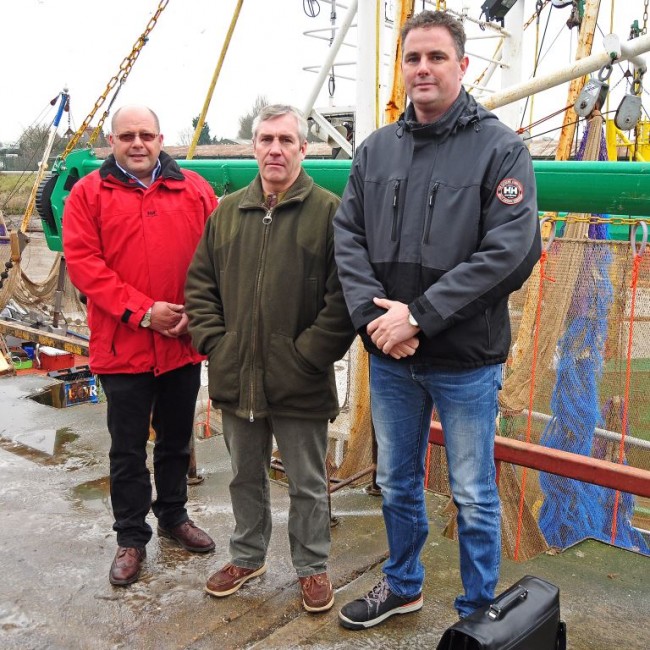A new type of shrimp gear, claimed to have far less impact on the seabed, has arrived in the Wash, reports John Worrall.
Above: The SeeWing beam maintains a lower trawl front-end profile.
The SeeWing has been acquired in a joint initiative by King’s Lynn processors/boat owners, John Lake Shellfish, and Lynn Shellfish, to find a way forward for a fishery facing creeping area closures, as more features requiring protection (notably Sabellaria spinulosa – Fishing News, 5 November 2015) are identified within the Wash and North Norfolk Coast European Marine Site.
Developed in Holland by Visserij Coöperatie Urk (VCU), in response to a similar regulatory climate there, SeeWing is also claimed to reduce by-catch and fuel consumption, however the main driver has been a reduction in seabed impact.
In his presentation at the offices of Lynn Shellfish, VCU chief engineer Roeluf van Urk said that independent Belgian consultants, ILVO, in 2012, found the impact to be up to 80% lower than that of conventional gear.
The trick is in an inverted aerofoil beam, which maintains a lower front-end profile of the trawl, reducing the opening and, with it, by-catch, drag and swirl astern, while the ends of the beam are supported by plastic wheels, rather than slippers, thereby minimising seabed contact. A number of Dutch boats have been using it for a while, and it has more recently been taken up in Germany and Belgium.

The prime movers for SeeWing: left to right – Steven Williamson of Lynn Shellfish, Neil Lake of John Lake Shellfish, and Roeluf van Urk of VCU.
Whether it will be the complete answer to Eastern IFCA’s obligations – under which area closures hinge on proof that it doesn’t damage protected features, rather than proof that it does – remains to be seen, and the question of who pays for any further definitive monitoring or research deemed necessary also arises.
But for now, the industry is putting its money up, and this first set of equipment will now go shrimping – and Fishing News will shortly see it in action. SeeWing doesn’t come cheap, costing three or four times more than conventional shrimp trawls, but if it keeps grounds open, it will be worth it.
Read more from Fishing News here.


A new type of shrimp gear, claimed to have far less impact on the seabed, has arrived in the Wash, reports John Worrall.
Above: The SeeWing beam maintains a lower trawl front-end profile.
The SeeWing has been acquired in a joint initiative by King’s Lynn processors/boat owners, John Lake Shellfish, and Lynn Shellfish, to find a way forward for a fishery facing creeping area closures, as more features requiring protection (notably Sabellaria spinulosa – Fishing News, 5 November 2015) are identified within the Wash and North Norfolk Coast European Marine Site.
Developed in Holland by Visserij Coöperatie Urk (VCU), in response to a similar regulatory climate there, SeeWing is also claimed to reduce by-catch and fuel consumption, however the main driver has been a reduction in seabed impact.
In his presentation at the offices of Lynn Shellfish, VCU chief engineer Roeluf van Urk said that independent Belgian consultants, ILVO, in 2012, found the impact to be up to 80% lower than that of conventional gear.
The trick is in an inverted aerofoil beam, which maintains a lower front-end profile of the trawl, reducing the opening and, with it, by-catch, drag and swirl astern, while the ends of the beam are supported by plastic wheels, rather than slippers, thereby minimising seabed contact. A number of Dutch boats have been using it for a while, and it has more recently been taken up in Germany and Belgium.

The prime movers for SeeWing: left to right – Steven Williamson of Lynn Shellfish, Neil Lake of John Lake Shellfish, and Roeluf van Urk of VCU.
Whether it will be the complete answer to Eastern IFCA’s obligations – under which area closures hinge on proof that it doesn’t damage protected features, rather than proof that it does – remains to be seen, and the question of who pays for any further definitive monitoring or research deemed necessary also arises.
But for now, the industry is putting its money up, and this first set of equipment will now go shrimping – and Fishing News will shortly see it in action. SeeWing doesn’t come cheap, costing three or four times more than conventional shrimp trawls, but if it keeps grounds open, it will be worth it.
Read more from Fishing News here.

